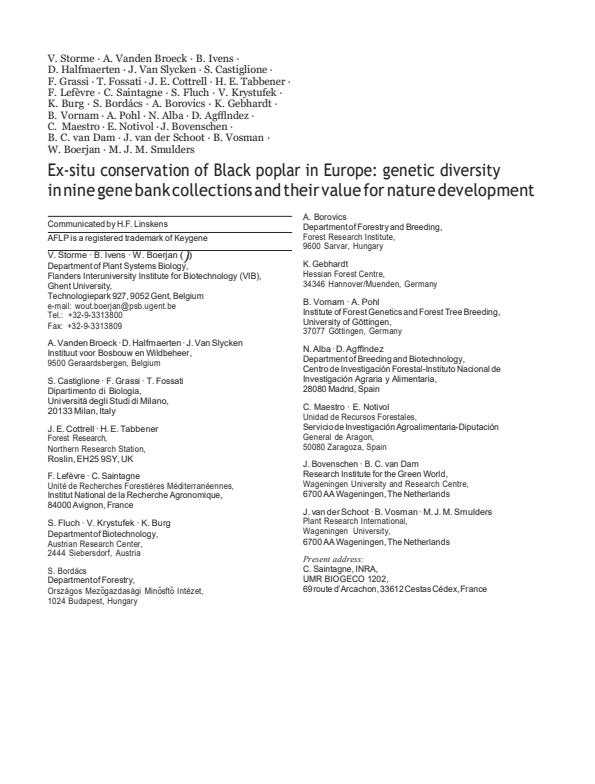Ex-situ conservation of black poplar in Europe. genetic diversity in nine gene bank collections and their value for nature development
Details
| Aantal pagina's | 13 |
|---|---|
| Volume | 108 |
| Pagina's (van-tot) | 969-981 |
| Type | A1: Web of Science-artikel |
| Categorie | Onderzoek |
| Tijdschrift | Theoretical and applied genetics |
| Issns | 0040-5752 |
| Uitgeverij | Springer Verlag |
| Taal | Engels |
Bibtex
@misc{85f4ac7e-3205-41e7-a57b-17277bdca25f,
title = "Ex-situ conservation of black poplar in Europe",
abstract = "Populus nigra L. is a pioneer tree species of riparian ecosystems that is threatened with extinction because of the loss of its natural habitat. To evaluate the existing genetic diversity of P. nigra within ex-situ collections, we analyzed 675 P. nigra L. accessions from nine European gene banks with three amplified fragment length polymorphism (AFLP) and five microsatellite [or simple sequence repeat (SSR)] primer combinations, and 11 isozyme systems. With isozyme analysis, hybrids could be detected, and only 3% were found in the gene bank collection. AFLP and SSR analyses revealed effectively that 26% of the accessions were duplicated and that the level of clonal duplication varied from 0% in the French gene bank collection up to 78% in the Belgian gene bank collection. SSR analysis was preferred because AFLP was technically more demanding and more prone to scoring errors. To assess the genetic diversity, we grouped material from the gene banks according to topography of the location from which the accessions were originally collected (river system or regions separated by mountains). Genetic diversity was expressed in terms of the following parameters: percentage of polymorphic loci, observed and effective number of alleles, and Neis expected heterozygosity or gene diversity (for AFLP). Genetic diversity varied from region to region and depended, to some extent, on the marker system used. The most unique alleles were identified in the Danube region (Austria), the Rhône region (France), Italy, the Rijn region (The Netherlands), and the Ebro region (Spain). In general, the diversity was largest in the material collected from the regions in Southern Europe. Dendrograms and principal component analysis resulted in a clustering according to topography. Material from the same river systems, but from different countries, clustered together. The genetic differentiation among the regions (Fst/Gst) was moderate.",
author = "V Storme and An Vanden Broeck and B Ivens and David Halfmaerten and Jozef Van Slycken and S Castiglione and F Grassi and T Fossati and J. E Cottrell and H. E Tabbener and F Lefèvre and C Saintagne and S Fluch and V Krystufek and K Burg and S Bordacs and A Borovics and K Gebhardt and B Vornam and A Pohl and N Alba and D Agundez and C Maestro and E Notivol and J Bovenschen and B. C van Dam and J van der Schoot and B Vosman and W Boerjan and M. J. M Smulders",
year = "2004",
month = jan,
day = "01",
doi = "https://doi.org/10.1007/s00122-003-1523-6",
language = "Nederlands",
publisher = "Springer Verlag",
address = "België,
type = "Other"
}
Auteurs
V StormeAn Vanden Broeck
B Ivens
David Halfmaerten
Jos Van Slycken
S Castiglione
F Grassi
T Fossati
J. E Cottrell
H. E Tabbener
F Lefèvre
C Saintagne
S Fluch
V Krystufek
K Burg
S Bordacs
A Borovics
K Gebhardt
B Vornam
A Pohl
N Alba
D Agundez
C Maestro
E Notivol
J Bovenschen
B. C van Dam
J van der Schoot
B Vosman
W Boerjan
M. J. M Smulders

